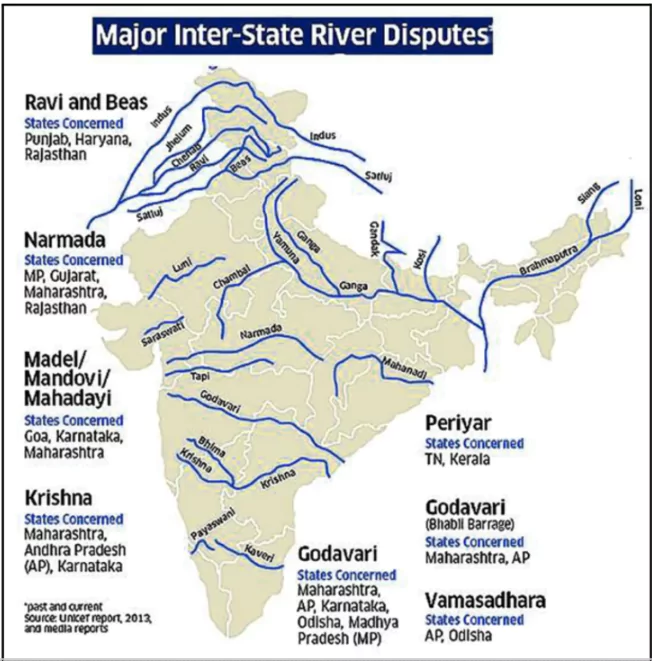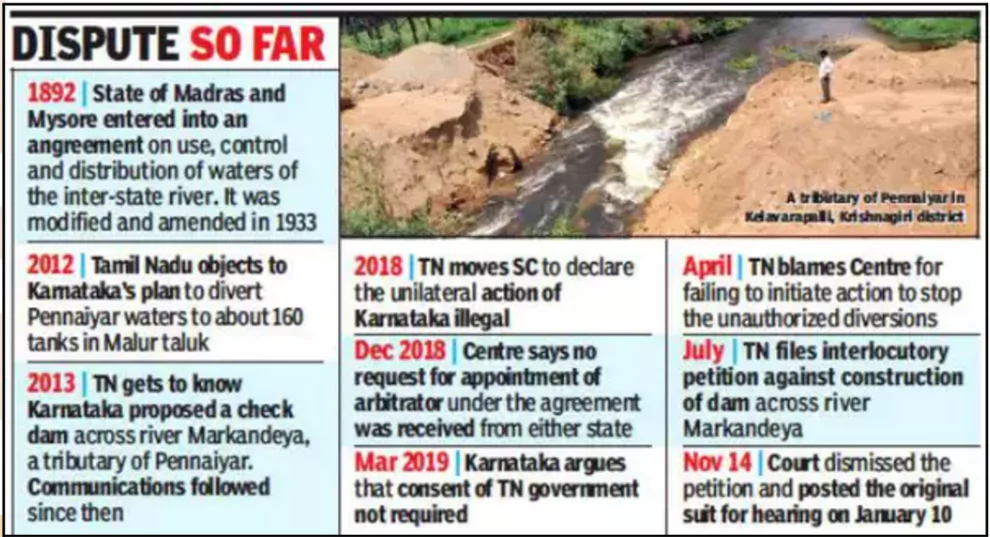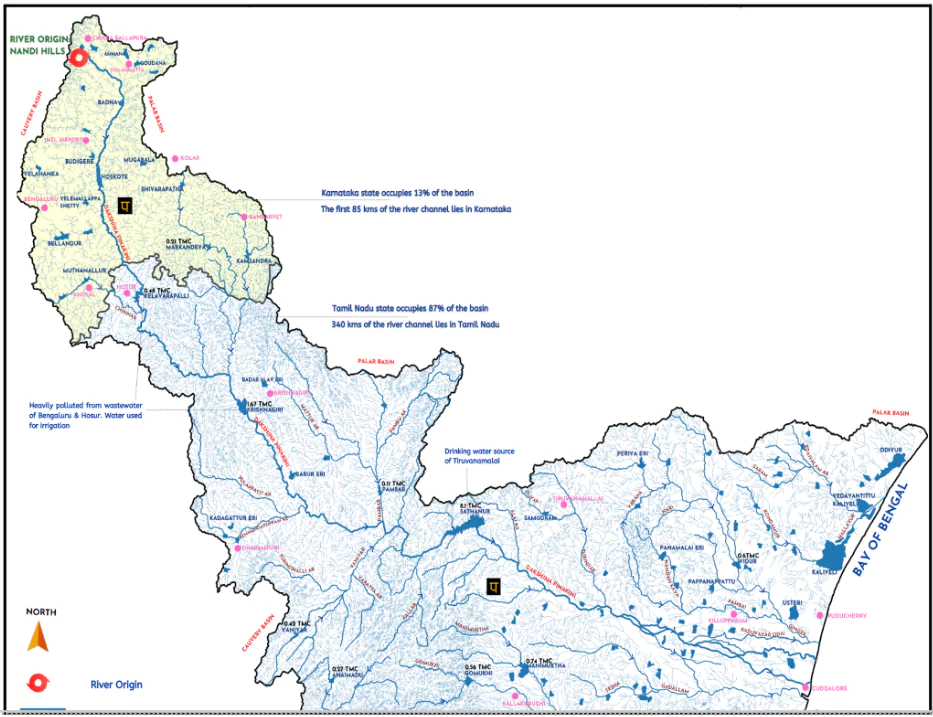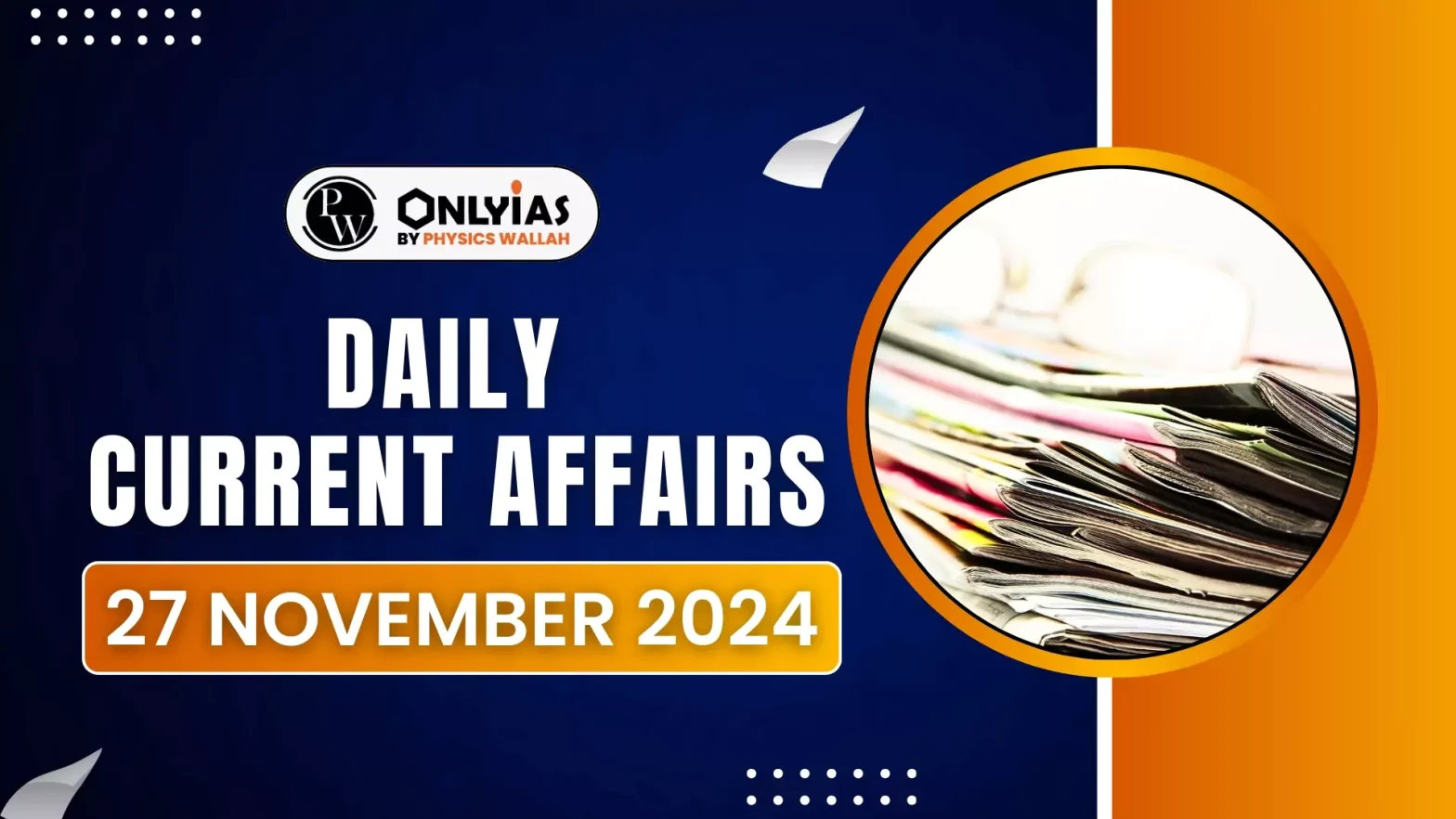Recently the Supreme Court asked the Union government to submit a report prepared by the Negotiation Committee addressing the dispute on Pennaiyar River Water Dispute.
Key Highlights of the Case

- SC Deadline: A two-week deadline was granted to the Union government to produce the report.
- Tamil Nadu’s Concerns: Tamil Nadu approached the Supreme Court in 2018, opposing Karnataka’s construction of check dams and diversion structures on the Pennaiyar River.
- Tamil Nadu argued the river’s flowing water is a national asset; Karnataka cannot unilaterally claim its waters to the detriment of Tamil Nadu residents.
- Validity of the 1892 Agreement: Tamil Nadu asserted that the 1892 agreement remains valid and binding on both States and emphasized that the agreement includes not just the main river but its tributaries and contributing streams.
- Markandeya River Contention: Tamil Nadu argued that the Markandeya River, a major tributary with a catchment area spanning both States, falls under the 1892 agreement.
- Tamil Nadu opposed Karnataka’s construction of diversion structures and large dams on the Markandeya River, calling it untenable under the agreement.
Enroll now for UPSC Online Classes
Negotiation Committee on Pennaiyar River Water Dispute

- In January 2024, SC directed the Union government to form a new negotiation committee under Section 4 of the Inter-State River Water Disputes Act, 1956.
- Aim: To mediate and find a resolution between Tamil Nadu and Karnataka.
- Karnataka initiated negotiation efforts in 2023, following the formation of a new State government in May 2023.
Constitutional Provisions on Inter-State River Disputes
- Interstate River Water Disputes refer to disputes between two or more states regarding use, distribution and control of rivers flowing through them
- Entry 17 of the State List: It addresses matters related to water, including water supply, irrigation, canals, drainage, embankments, water storage, and hydroelectric power generation.
- Entry 56 of the Union List: It empowers the Union Government to regulate and develop inter-state rivers and river valleys to the extent declared by Parliament as necessary in the public interest.
- Article 262 of the Constitution: It grants Parliament the authority to enact laws for adjudicating disputes or complaints related to the use, distribution, or control of the waters of any inter-state river or river valley.
- Parliament may also provide through legislation that neither the Supreme Court nor any other court shall exercise jurisdiction over such disputes.
- Judicial Limitations: The Supreme Court cannot question the award or formula given by a tribunal established for inter-state water disputes.
- However, it retains the authority to review the functioning of the tribunal.
Process of Tribunal Formation Under Inter-State Water Disputes Act, 1956
- If one or more states request the Centre to resolve a water dispute, the Central Government is first required to attempt a resolution through consultation among the concerned states.
- If consultations fail, the Centre may establish a tribunal to address the dispute.
- The 2002 amendments to the Act introduced a one-year deadline for constituting a water disputes tribunal.
- The amendments also mandated that the tribunal must deliver its decision within three years.
International Rules for Water Disputes
Helsinki Rules (1966)
- Equitable Utilization: Water should be utilized equitably by all riparian states.
- Riparian states are countries or regions that share a common river or water body, and have rights and responsibilities regarding its use and management.
- No Significant Harm: No state should cause significant harm to other riparian states.
- Reasonable Use: Water should be used reasonably, considering the interests of all riparian states.
- Prior Utilization: Existing uses of water should be respected.
- Notification: States should notify other riparian states of planned water uses.
- Negotiation and Consultation: Disputes should be resolved through negotiation and consultation.
Berlin Rules on Water Resources (2004)
- Integrated Water Resource Management (IWRM): A comprehensive approach to water management considering all relevant factors.
- Ecosystem Approach: Protecting and restoring ecosystems to ensure sustainable water use.
- Public Participation: Involving stakeholders in decision-making processes.
- Gender Equality: Recognizing the role of women in water management.
- Capacity Building: Investing in education and training to improve water management skills.
- Transboundary Cooperation: Promoting cooperation among riparian states.
Check Out UPSC NCERT Textbooks From PW Store
About Pennaiyar River

- The Pennaiyar River is also known as Dakshina Pinakini in Kannada and Thenpennai, Ponnaiyar, or Pennaiyar in Tamil.
- Origin: The river originates from the eastern slope of the Nandidurg Mountain, located in the Chennakesava Hills of Karnataka.
- Course: The Pennaiyar River flows through Karnataka and enters Tamil Nadu before finally emptying into the Bay of Bengal.
- Basin Distribution: Approximately 77% of the Pennaiyar River’s drainage basin lies within Tamil Nadu.
- Length: The Pennaiyar River, with a length of 497 km, is the second-longest river in Tamil Nadu after the Kaveri River.
- Tributaries: Notable tributaries of the Pennaiyar River include the Markandeyanadhi, Kambainallur, and Pambar rivers.
- Important Cities Along the River: Major cities located on the banks of the Pennaiyar River include Bangalore, Hosur, Tiruvannamalai, and Cuddalore.
![]() 27 Nov 2024
27 Nov 2024




